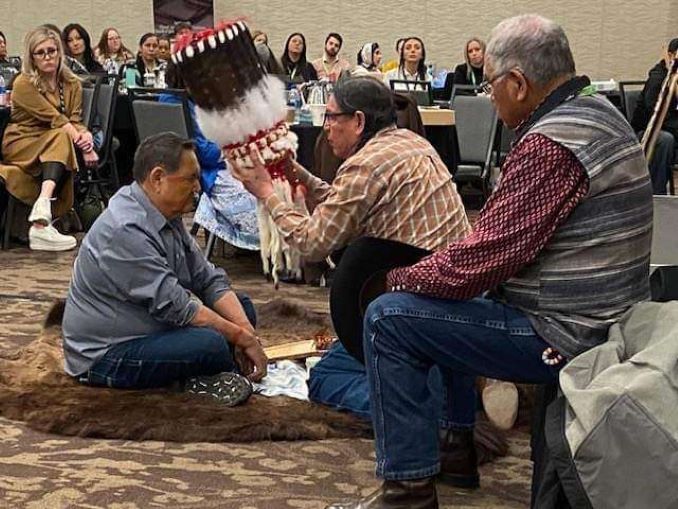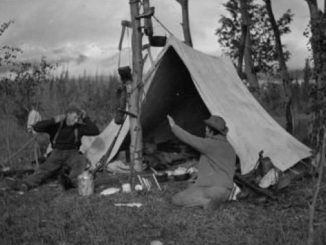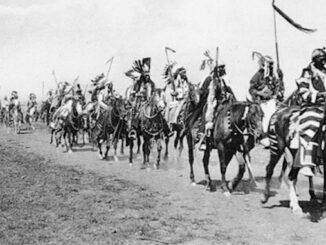A Pinto for the Prince is a 1979 documentary directed by Colin Low and John Spotton. The film is 16 minutes long and covers a 1977 visit from then-Prince Charles to the Blood or Kanai Reserve in Southern Alberta. During this visit, Prince Charles participates in a “capturing” ceremony, conducted in the great Circle of the Sun Dance. This particular Sun Dance (or Circle Camp as it is called in the Blackfoot Language) was held to commemorate the 100th anniversary of the signing of Treaty 7.

Originally signed in 1877, Treaty 7 was accepted by the Blackfoot Confederacy (along with the Stoney Nakoda and Tsuu’ Tina peoples) with the assumption that it would guarantee the signatories the protection of Queen Victoria, called “The Great White Mother”.
The purpose of the ‘capturing ceremony’ portrayed in the film was to induct Prince Charles into the Tribe as an “honourary chief,” to strengthen and renew this relationship that was formed in 1877.
The capturing is part of the headdress transfer ceremony. It’s to first “capture” the one receiving the headdress. Then, once captured, the person captured gets the rights to the headdress in the headdress transfer ceremony.
Colin Low and John Spotton were prolific directors for the NFB, but neither was Indigenous. For this review I decided to see if I could find a member of the Blackfoot Confederacy who had attended the events depicted in the film, to see how the film held up. I connected with Duane Mistaken Chief, who is a member of several societies that hold Blackfoot knowledge. He was 20 years old in 1977, and remembers the day well.
When I spoke with Mistaken Chief about the ceremony depicted in this film, I expected, perhaps even wanted, for him to ‘shit talk’ the now King, Charles III. To speak of broken promises and perhaps express a distaste for the monarchy. However, that’s not what happened.
As a Blackfoot Elder, Mistaken Chief helps to keep sacred teachings alive, memories of a different way of thinking than most people in a strictly capitalist society with explicitly capitalist modes of production, are familiar with. The Blackfoot, like many Indigenous Peoples in Canada, think of the world in terms of relationships. Not just between human beings, but between humans and animals, humans and land.
“Our ways are all about relationships”, Mistaken Chief explained to me “whether it’s the environment, the stars or people. We try to develop new relationships. Family keeps expanding, and it’s not about blood. We are always making new relatives.”
In today’s times we generally reserve the word ‘relationship’ to refer to romantic relationships exclusively, but the word has a much deeper meaning than that. It is the way in which two or more concepts, objects, or people are connected, or the state of being connected. For Mistaken Chief this is the definition he wants to stress, and the ceremonies, such as the capturing ceremony, are vital to acknowledging and renewing these connections.
Back in 1877, when Kainai leader Red Crow signed Treaty, it was an agreement made with Queen Victoria. 100 years later, in this film, Red Crow’s descendant and Head Chief of the Bloods, Jim Shot Both Sides, meets with Charles, descendant of Victoria, to renew and honour the relationship formed at the signing of this Treaty. Just as at the original signing, the Peace Pipe is smoked and gifts are given, to honour and renew the relationship.
Smoking together in Blackfoot culture is a very serious affair, and the relationship created by this act is not taken lightly. This is why Mistaken Chief has no ill words for the Monarchy. “It’s a wondrous sight to see someone come to camp and pay them so much honour,” says Mistaken Chief, “that’s what we do. We honour people. We are honouring our Mother’s son”
“Early people understood those processes better than today. Today the younger generation are more “activists”; they forget our traditions.” However even Mistaken Chief admits that he understands these ceremonies in a deeper way now than he did as the young man in attendance.
Early colonial thinkers seemed to believe that Treaties could be signed, and Indigenous peoples forgotten once the agreements were signed, that the “Indian Problem” could be made to disappear. In the introduction of the film the voice over paints a different picture: “When the Sun Dance camp was photographed 20 years ago, it was meant to be a record of something, it was meant to be a record of something that was about to vanish from the face of the earth; in 1977, there were more people than ever.”
Indeed the Sun Dance or Circle Camp, continues to be practiced to this day. Treaty 7, once only honoured at such special ceremonies, is spoken of more frequently, often in “Land Acknowledgements” before large gatherings of many different kinds. Some activists call them a waste of time that will not lead to any real reconciliation. While many of these critiques bring up valid points, may we also accept these land acknowledgements as an invitation; an invitation to strengthen our relationships with the land that we live on, and the people represented by the Treaty.




